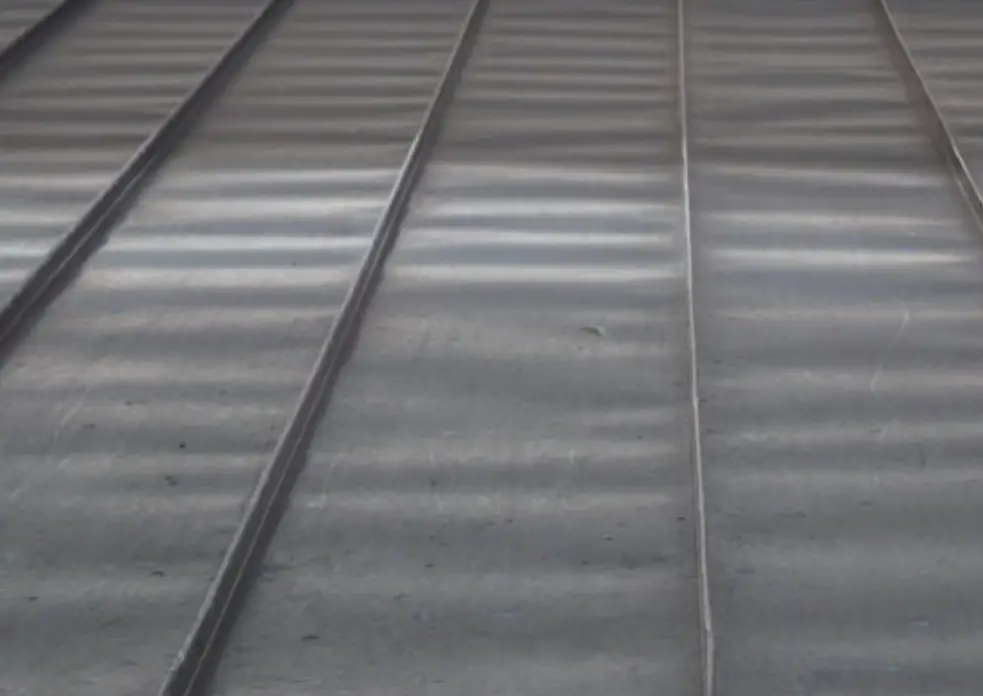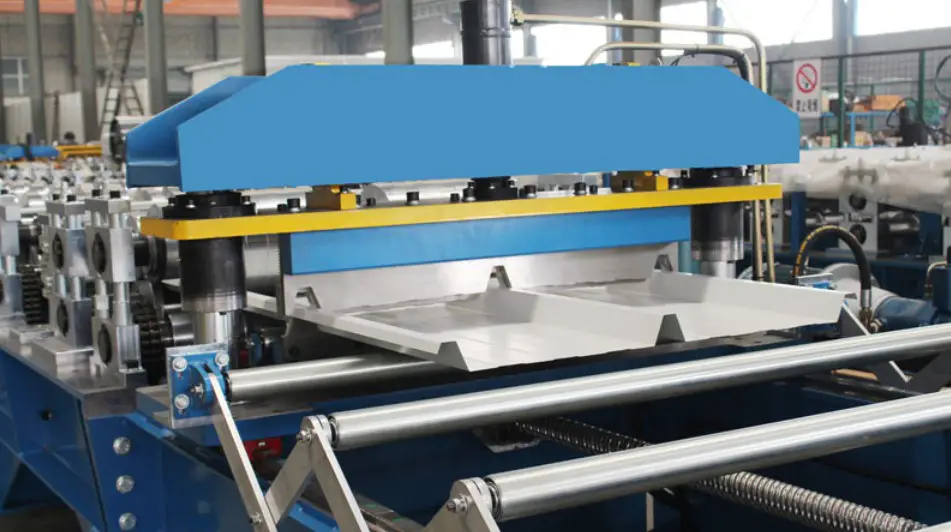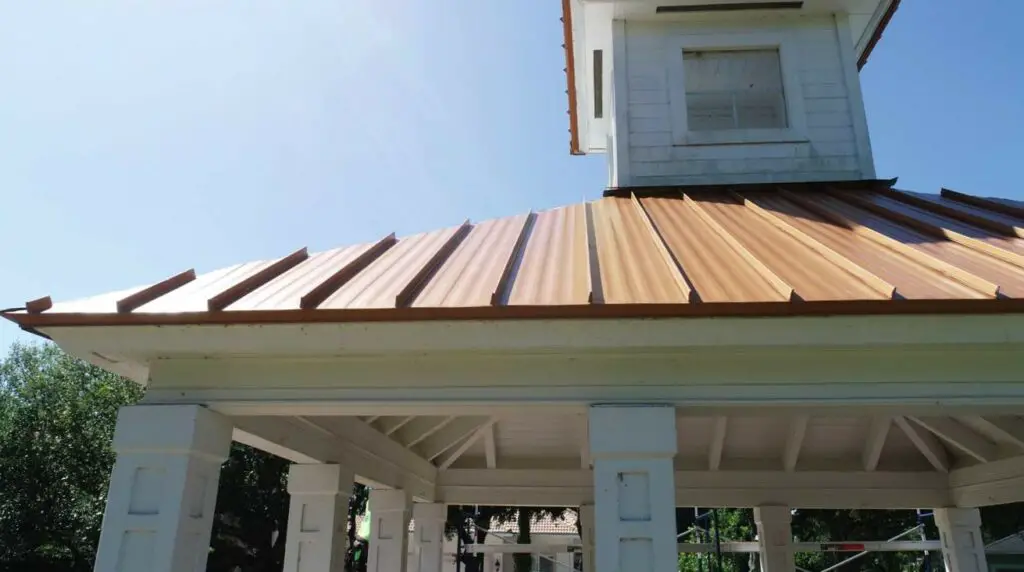Oil Canning in Metal Roof Panels • What You Should Know
By Jack Gray, Roof Online Editor • Last updated June 9, 2023

Table of Contents
Introduction
Metal roofing is an attractive roofing option. It looks great. It can be recycled. It’s lightweight. Metal panels can each provide the same coverage as dozens of shingles and they can weigh as little as 70 pounds per square (100 ft2).
Compare this to a clay tile roof that can weigh more than 1,000 pounds per square, or even asphalt shingles at around 300 pounds per square.
This means that metal roofing can be used on just about any structure without having to worry about expensive structural reinforcement.
But because they’re so thin and lightweight, metal roofing panels come with a few unique issues, and one of those issues is oil canning.
“Oil canning” refers to real physical distortions of the metal that detract from the desired flat and uniform appearance of the roof panels.
The term “oil canning” is used because the distortion of the flat metal panels reminded someone (at some point long ago) of the distortion created in the flat metal bottom of an actual oil can when pressure was applied to it in order to pump the oil out of the can.
Oil canning often looks like ripples in the panel; it can also look as if the panel has buckled slightly. If a metal panel appears wavy, that’s oil canning.
Some of the finishes applied to metal roofing panels are highly reflective or shiny and some metals, like stainless steel, are naturally shiny.
Shinier, more reflective surfaces will exacerbate the visual effect. The appearance may be pronounced in direct sunlight, but much less visible on the same roof on a cloudy day.
Oil canning does not affect roof performance, it’s an aesthetic issue. But it can be a big aesthetic issue.
What Metal Roofing Manufacturers Say About Oil Canning
According to a position paper issued by the Metal Construction Association:
“Oil canning can be defined as a perceived waviness in the flat areas of roofing and siding panels. Generally, the period and amplitude of the wave depend on the continuous width of the flat.
Oil canning is an inherent part of light gauge cold-formed metal products, particularly those with broad flat areas. Profiles having wide flat surfaces are often referred to as “architectural” roofing and siding panels.
Such panels are distinguished from corrugated shapes as the latter are more fluted in design, have much narrower flats, and are less likely to exhibit oil canning.”
So you can see that their position is basically that it is “an inherent part” of metal roofing. This is the position held by all metal roofing manufacturers. Metal roofing manufacturers almost universally issue disclaimers about oil canning, and do not cover it under their material warranties.
If metal roof panels arrive from the factory with severe oil canning, building owners may be able to reject them before they’re installed.
Manufacturers generally insist that oil canning is not an acceptable reason for panel rejection, so you might want to get something in writing before you order the material, particularly on large or high-visibility projects.
It will virtually never be covered if it appears after the installation process is complete.
Causes of Oil Canning
Oil canning is a common issue for metal roof systems and sheet metal roof accessories such as fascia or valley flashing. There are various reasons why it occurs, such as manufacturing defects, incorrect storage of the material, incorrect installation of the panels, or restricted thermal expansion.
Even factors that don’t seem to be roof-related at all, such as building settlement, can be a source of oil canning. Building settlement will often lead to uneven roof decking (deflection of the roof deck). An uneven substrate will put uneven stresses on the metal panels.
Manufacturing Issues
A poor-quality metal coil is among the many things that can lead to oil-canning in metal roofing. Because of its high visibility, metal roofing generally demands more stringent manufacturing tolerances than what is currently typical in the sheet metal industry.
The roll-forming equipment itself can cause oil canning. It can happen when the coil fed through the rollers lacks a straight edge.
The coil may also develop a slight side-to-side curve, also known as “side camber”. This can cause oil canning by putting uneven stress on the metal during the forming process when the machine tries to straighten the panel.
If the blades used for cutting the coil to the desired panel width are dull or out of alignment, the metal may stretch even if the original coil was properly flat.
And even if the metal panels arrive from the factory perfectly flat surface, oil canning can still occur during and after the installation of the panels.

Thermal Expansion
One crucial thing to be aware of is that metal roofing panels need to have enough room to be able to freely expand and contract according to daily temperature changes.
If there are improper movement restrictions imposed on the panels at fastener or clip locations, at roof penetrations like plumbing vents, or because the panels are installed too tightly together, oil canning will almost certainly result.
Metal roof panels need a little wiggle room to move in. You can’t pin them in place.
A Personal Experience with Oil Canning
I was called in by a roofing contractor one time to investigate a terrible case of oil canning on the new metal roof he had recently installed on a newly-constructed building.
The owner and the general contractor claimed that the unsatisfactory appearance of the roof was the fault of the roofers. (The roofing contractor wanted a second opinion.)
After checking the roof’s supporting structure, it was obvious to me that there had been a great deal of building settlement. (Structural support posts made from multiple 2x12s fastened together were being pulled apart by abnormal forces, among other clues.)
After checking the plane of the roof by holding one end of a string near the top of the panels, and the other end near the bottom, and pulling it tight, we were able to see that the surface of the roof deck was well more than a foot out of its proper plane all along the middle of the roof.
The building’s structural integrity had clearly been compromised and the oil canning in the metal panels was obviously due to the severely uneven roof decking. The general contractor dropped his accusations.
I’ve also seen metal roofing panels delivered from the factory by a highly reputable metal roofing manufacturer already showing oil canning, so factory defects can certainly happen.
How to Avoid Oil Canning in Metal Roofing
There are a few standard methods for preventing or reducing oil canning. If you use thicker metal, narrower panels, or ribbed panels, you can substantially reduce the chances of it happening.
Another technique is to use backer rods to help stabilize the panels. Backer rod can be installed lengthwise under the center of the entire panel, providing a measure of dimensional stability. (You can read more about backer rod here.)
Advice from the NRCA
Here’s what the National Roofing Contractors Association says about reducing the risk of oil canning on your roof:
“The following are considerations to limit or reduce oil canning:
- Specify that coil stock be tension-leveled to ensure the flatness of the material.
- Use thicker metal because thicker metals are more rigid and tend to oil-can less than thinner metals.
- Limit individual panel pan widths.
- Limit face dimensions in fascia metal.
- Use stiffening ribs in the pan of the metal panel.
- Use stiffening ribs in fascia metal or use two pieces of fascia metal when face dimensions are greater than 8 inches (200 mm).
The following are considerations to reduce the visual effects of oil canning:
- Use low-gloss paints or special finishes, such as embossing or striations.
- Consider using metals that are naturally weathering since these metals typically dull or fade over time with the development of a layer of oxidation.”
(From the NRCA’s Architectural Sheet Metal and Metal Roofing Manual, Fifth Edition)
Metal Panel Profile
Hemming, bending, or folding sheet metal is a common technique in metal fabrication to improve the dimensional stability of sheet metal products.
That principle is used in metal roofing when the panels are produced with ribs or striations. Striations are small, linear grooves or raised patterns on the surface of the metal.
Metal roof panels (called “metal shingles” or “metal tiles”) that are designed to mimic the appearance of shingles, slate, or clay tiles tend not to experience oil canning. The embossed patterns or stamped contours on metal shingles that make them look like other roofing materials also function as stabilizing striations.
Ribbed or corrugated panels are far less likely to oil can than flat panels because the ribs stabilize the sheet and help it maintain its shape. And by the way, the standing seams in a standing seam metal roof are not ribs, and have a minimal effect on this problem.
Some standing seam metal roofing manufacturers will add small ribs or striations to their standard flat panels upon request, so that’s something to consider.
The risk of oil canning in flat metal panels is fairly high, and it increases with the width of the flat surface of the panel.

Metal Panel Width
Panel width affects the likelihood of oil canning. The wider the panel, the more likely it is to happen. Selecting narrow widths for your panels can minimize oil canning.
Metal roofing panels have different widths depending on the manufacturer and the specific product. There is a degree of standardization, however. Commonly-available standard metal panels will be anywhere from 12 inches to 36 inches wide, with 24 inches being the most common.
If oil canning is a primary concern, you’ll be better off using a 12-inch panel than a 36-inch panel.
Metal Panel Thickness
The normal thickness of sheet steel used for roofing is 24 gauge (0.025 inches or 0.64 mm). However, 26-gauge or 28-gauge architectural panels are also widely used, and that’s where you should be more concerned. Steel with a lower gauge number will perform better.
24 gauge steel is generally strong enough and thick enough to make a roof panel that won’t display an intolerable level of oil canning. 22 gauge steel will perform even better.
The normal thickness of aluminum used for roofing panels is 0.032 inch or 0.8 mm (aluminum sheet thickness is not measured in gauge). If you want to minimize oil canning in aluminum roof panels, a 25% thicker panel (at least 0.040 inches or 1 mm thick) should be specified.
Metal Panel Installation
Poor installation methods can lead to excessive oil canning.
Panel Layout
Metal roof panel systems typically have a specific limit regarding how close together the panels can be installed. If you violate this tolerance, the panels may not have enough room for thermal expansion and contraction.
This expansion is an inherent characteristic of all materials, but it’s particularly pronounced in metal. If you restrict it, your panels will almost certainly display oil canning, if they don’t outright warp and buckle.
The manufacturer’s installation instructions regarding the spacing of the panels should be closely adhered to in order to help prevent this and other issues.
Fasteners and Penetrations in Metal Roofs
Metal roof panels need to be able to expand and contract freely according to the properties of the metal being used. Fastening instructions from the manufacturer must be followed.
Metal panels designed to be secured with fasteners will typically have pre-drilled fastener holes and specified fasteners that will properly allow for thermal expansion.
Standing seam panels are generally attached with clips. The clips are fastened to the roof decking, but they allow the panels themselves to slide as needed.
A common root cause of metal roofing issues is people altering a metal roof at a later time after it has been installed. People attach things to the roof and hammer nails through the panels. People cut holes in metal roofs for plumbing vents or other penetrations.
A nail hammered through a panel will pin the panel at that point. If the hole made for a plumbing stack is too tight around the pipe, it will fix the panel at that point. Pinning a panel in place is a good way to get oil canning. And if the panel is double-pinned, it’s almost certain.
Coatings and Finishes
You can reduce the appearance of the oil canning effect by using matte finishes to disguise oil canning. Oil canning is an effect of lighting conditions and the way light reflects off the roof. Low gloss finishes that reduce reflectivity will also reduce the visible waviness associated with the issue.
Clear-coat finishes are often used to improve the color retention, fade resistance, durability, and corrosion resistance of other sheet metal coatings and paints.
Clear-coat finishes are beneficial in all of these ways, but they will also highlight any oil-canning since they tend to produce a high gloss sheen on the metal panels.
Other Roofing Components
Many other roofing components are made out of sheet metal. Fascia, coping, or other perimeter edge metal with wide flat areas can show oil canning. Oil canning can also occur in metal siding, a rain screen, or any other sheet metal wall system.
Again, the use of stiffening ribs, striations, and thicker gauge metal can improve your chances of having a roof accessory free of visual defects.
About the Author
Jack Gray is a principal roof consultant and vice president at the Moriarty Corporation, an award-winning building enclosure consultant firm founded in 1967. He is also the editor of the Roof Online website.

Mr. Gray has worked in the roofing industry for over 25 years, with training and practical experience in roof installation, roof inspection, roof safety, roof condition assessment, construction estimating, roof design & specification, quality assurance, roof maintenance & repair, and roof asset management.
He was awarded the Registered Roof Observer (RRO) professional credential in 2009.
He also served as an infantry paratrooper in the 82nd Airborne Division and has a B.A. from Cornell University. Read full bio.
